In peace or war, by day or by night, the Navy works unceasingly. As the guardian of the world's most widespread Empire, its diverse activities and responsibilities are unique
THE NAVY GOES TO WORK - 1
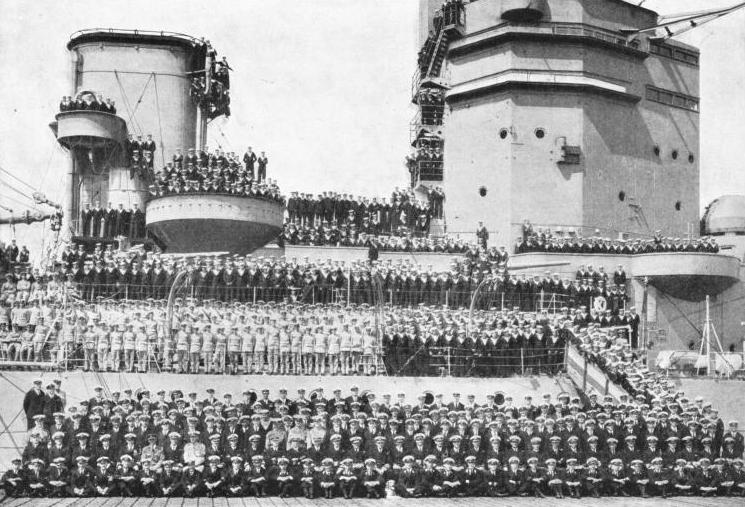
THE PERSONNEL OF THE ROYAL NAVY, at the end of 1935, numbered about 7,810 officers of commissioned and warrant rank, and 86,672 petty officers, seamen and marines. There were in addition about 7,000 officers and men of the Dominion Navies. Above are the officers and ship's company of H.M.S. Nelson, with the former Commander-in-Chief of the Home Fleet, Admiral Sir John Kelly, G.C.V.O., K.C.B., C.B.
ALTHOUGH the Navy is, perhaps, the most British of all our national institutions, and holds a special place in the affections of our people, it is a service about which the public knows comparatively little. From time to time men-of-war visit seaside resorts, and on rare occasions a Naval Review is held at Spithead, as in July, 1935. But an hour spent on board a warship, or a cruise down the lines at a Review, is more apt to bewilder than to enlighten.
The modern fighting ship of any type, from battleship to submarine, is so crammed with mechanism and “gadgets” that only the trained eye can take in the full significance of what it sees. The Navy, too, speaks a language which, to the uninitiated, is meaningless jargon. This is particularly noticeable at “Navy Week”, now an annual event at the three great naval ports of Chatham, Portsmouth and Plymouth. However patiently the guides may explain the mysteries of a battleship’s gun-turret or the control-room of a submarine, even the most intelligent hearer finds it difficult to follow the technical words and phrases with which the exposition is necessarily interlarded. And so the Navy remains more or less unknown to the nation it serves.
From the Mall or Horse Guards Parade we may view the buildings of the Admiralty, the head office of an organization that literally spans the globe. On the roof is visible the high-powered wireless installation which enables “My Lords” to communicate with the King's ships wherever they may be, from the Channel to Chile, from the Indian Ocean to the ice-bound coasts of Labrador.
In the Admiralty main building you may be privileged to visit the Board Room, where the civilian First Lord and the four Sea Lords, with the Deputy and Assistant Chiefs of Staff - “Admirals all” - who comprise the Board of Admiralty, meet to decide major and minor points of policy. These range from a programme of new construction costing £20,000,000 to the question of whether a request from a junior officer is to be “allowed” or “not approved”.
As an indication of what a gigantic business it is to run the British Navy from day to day, the fact that the staff of the Secretary of the Admiralty alone numbers 570 people is significant. The Admiralty itself is divided into more than fifty divisions, departments, and committees, most of which are again sub-divided, and so, almost, ad infinitum. The personnel of the Navy proper stands at the time of writing at slightly over 94,000, but the civilian staff at home and abroad, including dockyard officials and workers, cannot fall far short of this figure.
A warship in full commission is a microcosm of the Navy as a whole. Certain officers and men are on duty at all hours of the day and night; and whether the time be midday or midnight, the second “dog watch” (6 to 8 p.m.) or the “middle watch” (midnight to 4 a.m.), a bugle call will bring every officer and man to his post, ready to set in motion all the complicated machinery of the ship.
The Navy never rests, for the sufficient reason that its work is never done. What, then, is that work? Turn to a map of the world, or, better still, to a commercial chart, which shows the tracks of innumerable ships passing and re-passing from one part of the globe to another. The largest proportion of those ships is British; upon their safety depends the welfare of every inhabitant of the British Isles. Since the greater part of the foodstuffs and raw materials we consume comes from overseas, safe navigation is the first condition of national existence.
Primarily, therefore, the Navy’s task is to keep the sea routes open and reasonably safe at all times and in all circumstances. If it can accomplish that purpose, not only will our supplies be assured but our shores will also be safe from invasion, for secure communications postulate command of the sea.
It is true enough that the conquest of the air has introduced a new and disturbing element into the problem of national defence, and it may as well be admitted without argument that the Navy is no longer the “sure shield” against foreign aggression that it was before the advent of aircraft. Fundamentally, however, the mission of the Navy remains unaltered. More than ever is an adequate navy essential for safeguarding our 85,000 miles of sea communications, for every year Great Britain tends to become more and more an industrial and less and less an agricultural community, our dependence on imported food and materials increasing in proportion.
Maintaining Trade Routes
In one important way the British naval forces are on an entirely different footing from those of every other country. That is because while every foreign fleet is concentrated in and about its own waters, the British fleet is dispersed over the Seven Seas. Another glance at the map will explain why. The British Commonwealth of Nations is world-wide, and its remotest territories and traffic lanes stand as much in need of defence as the coast of Britain and the English Channel.
Every month the Admiralty publishes the “Navy List” - in effect, a periodical directory of our naval forces, showing where every officer and every ship on the active list is serving at a given date. According to this guide, of the ten separate and distinct fleets and squadrons now in commission, only one is stationed in home waters. Our most powerful fleet, the Mediterranean command, is based at Malta, 2,000 miles from England. There is another strong squadron at Hong Kong, nearly 10,000 miles away; and the East Indies, the West Indies, South Africa, Australia, New Zealand and Canada have each squadrons of cruisers and smaller craft. In certain contingencies ships might be taken from one squadron to reinforce another, but in no imaginable instance, would it be possible to concentrate our entire naval forces, or even the great majority of them, in one single area. That is a simple truth which is liable to be overlooked when estimating the naval requirements of the British Commonwealth. Dispersion of strength is against all the canons of strategy, but it is a policy which destiny and geography have forced upon us, and of which we have to make the best.
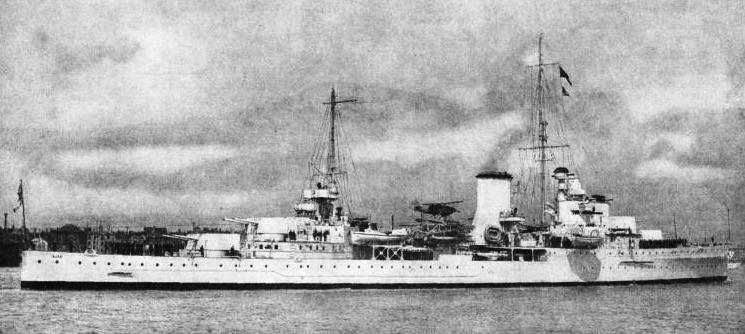
H.M.S. AJAX. This ship has a displacement of 7,030 tons, an overall length of 554½ ft and a beam of 55 ft 2-in. Armament consists of eight 6-in guns, four 4-in and a number of smaller weapons, excluding eight 21-in torpedo tubes in quadruple mounts. The designed speed of Ajax is 32½ knots.
Due to the great progress of naval science within the last twenty-five years, the training of officers and men has become infinitely more arduous and exacting. Not only have certain types of ships doubled, and even trebled, in size, but their propelling machinery and fighting equipment have also undergone radical changes, not always in the direction of simplicity. Thus the modern naval man has to be both sailor and skilled mechanic. In some departments an error of judgment may endanger a ship worth millions and a thousand invaluable lives. Hence the care devoted to the education of officers and ratings, and the rigid, yet by no means inhuman, discipline which is peculiar to the Navy. The Navy is continuously training itself to be ready for emergencies which may never arise, and in so doing it fulfils its mission of keeping the peace on the high seas.
Since the naval calendar varies according to locality, it will be more convenient to summarize the working year of a single command - the Home Fleet. The three outstanding events of the year are the spring, summer and autumn cruises. In normal times the spring cruise, which starts about the middle of January, takes the Fleet to Gibraltar, whence it engages in combined manoeuvres with the Mediterranean Fleet, either in the Mediterranean itself or, as in 1934 and 1935, in the open Atlantic.
On returning to England, the Fleet gives Easter leave of fourteen days, the first instalment of the forty-two days’ annual leave to which every member of the Navy is entitled. For this purpose the ship’s company is divided into two “watches”, so that throughout the leave period one-half of the crew is on board. As likely as not the ship goes into dock for those minor repairs which are always necessary after a spell of training at sea, during which the vessel herself and her equipment have been worked at high pressure, and the vibration of the engines at full power and the tremendous concussion of her own guns have exposed structural weak-nesses which demand attention. Even when she is in dockyard, however, the routine of the ship goes on. Drills and exercises of one sort or another occupy most of the fifteen hours that the bluejacket spends out of his hammock.
An Inspiring Spectacle
For the younger seamen and boys there are daily classes, presided over by the instructor officer and his schoolmaster assistants. The gunnery staff, the torpedo branch - which, incidentally, is responsible for much of the complex electrical system of a modern ship - the signals branch, and the engineering department are all hard at work; while the non-specialists attend to their duty of keeping the ship clean and smart inside and out, and in constant readiness for going to sea.
The summer cruise, which begins in July, is generally made in Scottish waters, and after the programme of exercises has been completed the ships disperse for “flag-showing” visits to Continental ports and British seaside resorts. In fact, the tail-end of the summer cruise is a sort of “stand-easy”. Then the Fleet returns to its bases for the second period of leave-giving and refit. By mid-September it is ready for the autumn cruise, which more often than not proves to be the most strenuous phase of the year. At the start of this cruise, the various divisions of the Fleet sail from Plymouth, Portsmouth, and the Nore, and meet at a rendezvous in the Channel, whence the combined force steers a course for Scotland. As a rule the cruisers, destroyers and submarines go first to the Firth of Forth, leaving the big ships to proceed alone to Cromarty and Invergordon, those spacious anchorages opening off the Moray Firth. As this is a part of the North Sea where there is little traffic other than fishing craft, it is an ideal area in which to conduct battle practice and other tactical exercises that demand plenty of sea room. When, as often happens, the sky is grey and lowering and the sea is stippled with “white horses” by a keen blast from the north-east, the spectacle of the whole fleet manoeuvring as a unit, or of a squadron doing a full-calibre “shoot” with its big guns, is one of majestic grandeur.
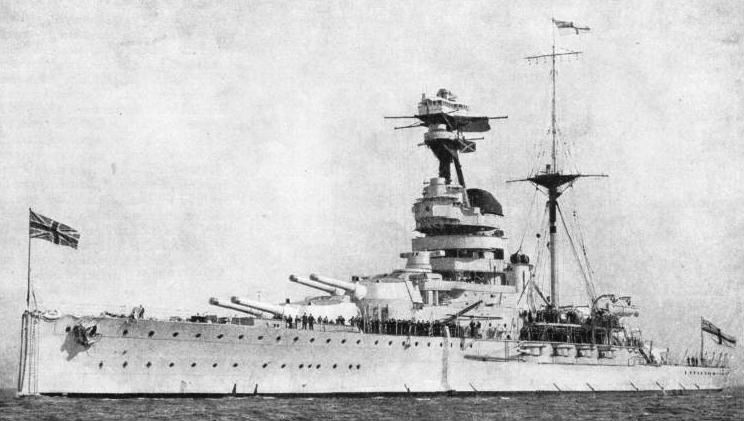
ONE OF THE FINEST CAPITAL SHIPS of the British Navy, H.M.S. Resolution. This fighting ship has a displacement of 29,150 tons, a speed of 23 knots, and was completed in 1916. The thickest armour the vessel carries measures 13-in. H.M.S. Resolution is equipped with eight 15-in guns, twelve 6-in and four 4-in. She is the sister ship of H.M.S. Royal Sovereign, Royal Oak, Ramillies and Revenge. These ships were completed in 1916, except Ramillies, which was finished the following year.
In these days of economy, when every ton of fuel-oil, every round of cordite and shell, has to be strictly accounted for, the Navy has no time for joy-riding or make-believe exercises. Never an hour is spent at sea without some variety of drill, and since every evolution has to be performed under the eagle eye of the commander-in-chief or divisional flag-officer, the officers and men taking part are keyed up to concert pitch. Praise or censure is forthcoming in the form of flag or flashlight signals visible to the whole fleet, a method of publicity which has its obvious advantages and disadvantages - the former more apparent to the commanding officer who receives a signal, “Well done!” than to his colleague in another ship whose signalman’s pad records, “Evolution badly performed”.
Towards the end of November the Fleet comes south again, to grant Christmas leave, refit, and make ready for the spring cruise. And so the eternal round of training goes on. Every month the Navy loses a certain proportion of its highly trained ratings whose term of service has expired. The gaps are filled by new entrants - boys from the training establishments at Shotley and Portsmouth, and young seamen enlisted under the “short service” five-year system. These newcomers are not, of course, equal in proficiency to the old hands whom they replace, and prolonged training is needed to turn them into competent ratings. Officers are so much occupied with instructional duties that their other work, such as gunnery, torpedo, navigation, signalling, and the like, is apt to suffer.
Down to 1931 the Third Battle Squadron, Home Fleet, consisting of the battleships Iron Duke, Marlborough, Benbow, and Emperor of India, was employed as a training squadron, each ship carrying about 300 boys. Besides helping to work the ships, these youngsters underwent special drills and educational courses; and so successful was the system that, after having spent twelve months with the squadron, the average boy had developed into a smart and capable seaman. The ships of this squadron were condemned to be scrapped by the London Naval Treaty. Since then boys passing out of the St. Vincent (Portsmouth) and Shotley establishments have been drafted direct to fully commissioned ships of the Home Fleet, where it is impossible to give them the same amount of instruction as they received in the Third Squadron. Further, as they are only partly trained and unfamiliar with their surroundings, their presence on board is a source of weakness rather than of strength. Eventually, when more ships are available, a new training squadron is likely to be formed. No modern naval officer would wish to recall the “good old days”, the passing of which is lamented by some retired admirals of the “shell-back” breed. There is still, and always will be, of course, a place in the Navy for the “salt horse” rating who does his duty in an unimaginative way, but who shuns responsibility and never takes the lead. To-day the lower deck of every King’s ship is tenanted by young seamen, of whom the majority intend to make the most of their chosen profession. The avenue of promotion to commissioned rank is still a narrow one, but it is being widened. Whatever fate may have in store for the Royal Navy, the quality of its future man-power is beyond criticism.
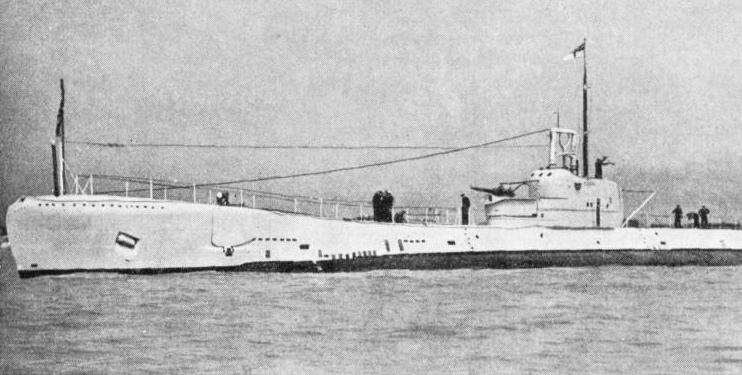
“THAMES” CLASS SUBMARINE. Severn was completed by Vickers-Armstrong in 1934, and has a length of 345 feet, a beam of 38 feet and a draught of 13 feet. Her surface displacement is 1,850 tons, surface h.p. is 10,000 and surface speed 22 knots. Her armament consists of one 4-in gun and six torpedo tubes. The fuel capacity of this submarine is 210 tons of oil.
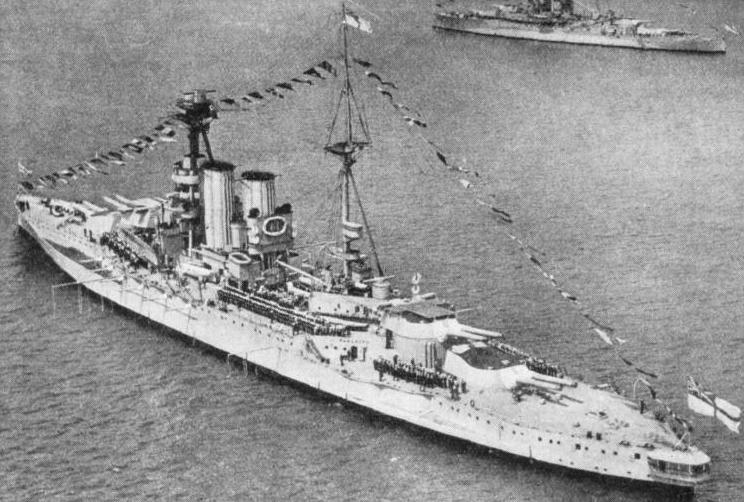
A “QUEEN ELIZABETH” CLASS SHIP, H.M.S. Warspite, which was completed in March, 1915. She has a displacement of 31,100 tons, a length between perpendiculars of 600 feet and a beam of 104 feet. She has a designed h.p. of 75,000, equal to 25 knots. Armament consists of eight 15-in guns, twelve 6-in, four 4-in, a number of smaller weapons and two 21-in torpedo tubes. The radius of action of this ship is about 4,400 miles. Reconstruction of this class included the trunking of the fore-funnel into the second.
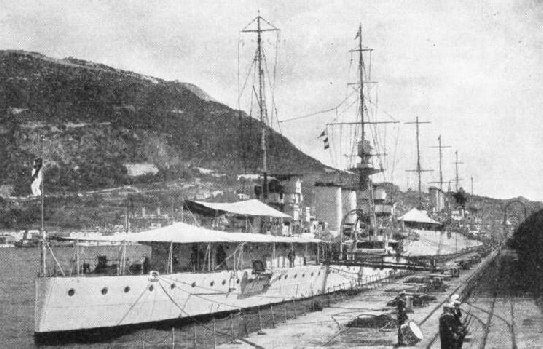
“D” CLASS CRUISER, H.M.S. Delhi, at Gibraltar. Completed June, 1919, H.M.S. Delhi has a maximum draught of 16½ feet, length between perpendiculars is 445 feet, and beam 46½ feet. Armour at the side, amidships, is 3-in. The cost of the ship was £840,182, and she was refitted in 1929-30. Armaments consist of six 6-in guns, three 4-in, four three-pounders, and twelve 21-in torpedo tubes in four triple deck mountings.
At the end of 1935 the material of the Navy, including vessels maintained by the Dominions and all ships building or authorized, consisted of fifteen capital ships - that is, battleships and battle cruisers, sixty-five cruisers, eight aircraft-carriers, 196 flotilla leaders and destroyers, sixty-three submarines, fifty-one sloops, and fifty miscellaneous vessels of the monitor, gunboat and mine-sweeping variety. The aggregate tonnage of all this floating material was approximately 1,140,000. The personnel of the Royal Navy numbered 7,810 officers of commissioned and warrant rank, and 86,672 petty officers, seamen, and marines. To these figures should be added some 7,000 officers and men of the Dominion Navies - Australia, Canada, New Zealand, and South Africa. Further, there is the Royal Indian Navy, the personnel of which, other than the officers, is entirely native. It has an establishment of 1,467 officers and men.
Though the mechanism of naval science tends always to become more intricate and complex, the differentiation of naval material is to-day much simpler than it was at the beginning of the century. At that date the Navy List presented a bewildering hotch-potch of ship categories. There were battleships of the first, second, and third class, “armoured coast defence ships”, armoured cruisers, “protected cruisers” (i.e. having an armour deck over their vital parts) of three classes, gunboats, despatch vessels, destroyers and torpedo-boats. To-day nearly all the combatant ships of the Navy are grouped under six heads: battleships, battle cruisers, cruisers, aircraft-carriers, flotilla leaders and destroyers, submarines. No one group, of course, consists entirely of uniform types, although there is much less diversity in type than existed before the war. Nowadays it is the custom to build ships in homogeneous series, a practice having several advantages. Not only is the first cost reduced by this modified form of mass production, but the fact that fittings and spare parts are interchangeable simplifies and cheapens the upkeep of the ships in service. Moreover, when a new ship’s company is drafted from one cruiser or destroyer to another of the same type, valuable time is saved in “shaking down”, because officers and men find themselves in familiar surroundings. A striking example of uniformity in construction is afforded by the fifty-two destroyers which have been built since 1927. In all these vessels the internal lay-out, the armament and general equipment are practically identical. Nor is there any marked individual difference between the thirteen big cruisers of the “County” class, or between the five battleships of the Queen Elizabeth group, or of the five Royal Sovereigns.
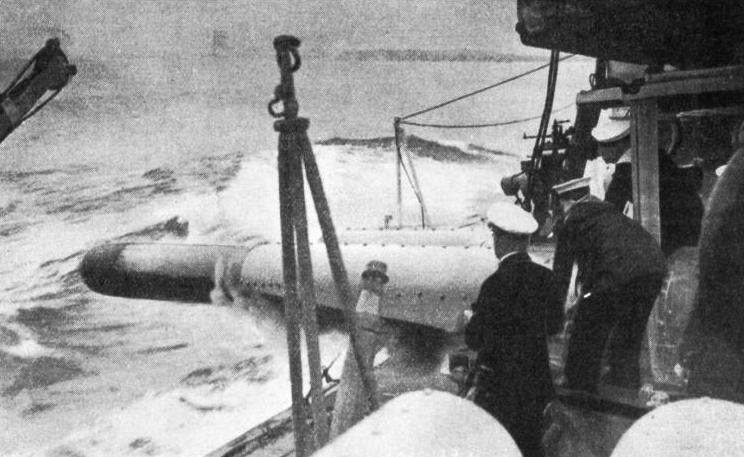
FIRING A TORPEDO from a destroyer. Torpedoes are fired from their tubes by a charge of powder or by compressed air. Engines drive the propellers after the torpedo has left the tube. Horizontal and vertical rudders - adjusted before firing - keep the torpedo in the desired direction and at the desired depth below the surface. Torpedoes at present in use in the British Navy vary from over 20-in to 14-in in diameter.
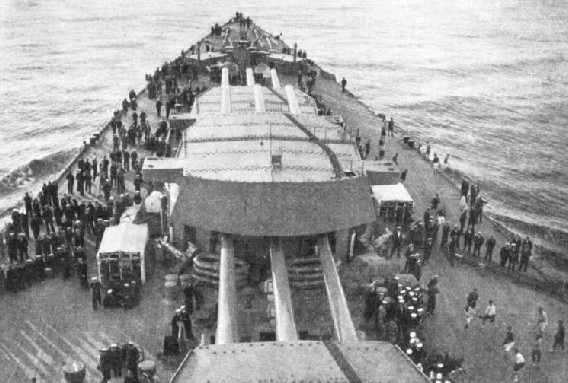
THE ARMOUR of H.M.S. Nelson, is largely concentrated over guns and magazines in the fore part of the ship. Main armament comprises nine 16-in guns, twelve 6 lb, six 4.7-in, and a number of smaller guns and two 24 in torpedo tubes. Designed speed is 23 knots and propulsion is by geared turbines. At full speed the oil fuel consumption is 16 tons an hour. The sister ship to H.M.S. Nelson is H.M.S. Rodney.
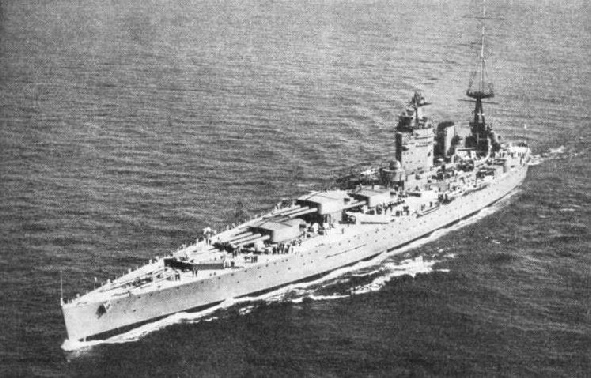
FLOATING FORTRESS. H.M.S. Nelson has a displacement of 33,500 tons, length between perpendiculars is 660 feet, and beam 106 feet. She was completed in 1927 and cost £7,504,000. The grouping of the main armament forward permits a minimum length of armoured citadel with maximum protection to hull and magazine.
It should be emphasized that a fleet comprising groups of homogeneous ships can be handled at sea with greater facility than one composed of many types, varying in speed and manoeuvring power.
Sensational Indictment
Almost on the eve of the war of 1914-18, Admiral Sir Percy Scott, the “father” of naval gunnery, startled the service world by declaring the battleship to be useless. He maintained that the submarine had made the seas unsafe for big surface warships. In future, he asserted, no Dreadnought could leave port without incurring the risk of certain destruction. We should, therefore, be well advised to stop building battleships, and devote our energies to the construction of light surface vessels and submarines. Coming from the man who, more than any other, had developed the power of the big naval gun which could be mounted only in the largest ships, this sweeping indictment of our naval policy raised a storm of controversy - only to be stilled within a month by the sudden and dramatic application of that acid test of all naval and military theories - war.
For the first few months of hostilities at sea it looked as if Sir Percy Scott had been right. No battleship, it is true, fell a victim to the new underwater menace, but in fewer than three months five British and several German cruisers succumbed to submarine attack. No event of the war made a deeper impression than the simultaneous destruction of three large British cruisers, each of 12,000 tons, by a small, antiquated German U-boat. Nor was this all. The submarine peril so far influenced naval strategy that for some weeks all the Dreadnoughts of the Grand Fleet vacated the North Sea, and sought sanctuary in the harbours of Western Scotland and Northern Ireland. It was believed, rightly or wrongly, that the main war base at Scapa Flow was accessible to enemy submarines. In these circumstances Sir Percy Scott’s persistent question, “What is the use of the battleship?” appeared to admit of but one answer.
After anti-submarine defences had been erected at Scapa the Grand Fleet returned there. Periodical “sweeps” were carried out in the North Sea, and there were times when thirty British Dreadnoughts were cruising in waters infested by hostile U-boats. Yet throughout the four years of the war not a single British Dreadnought was torpedoed by a submarine. The Grand Fleet’s immunity from this form of attack was due, in part, to the screening operations of its destroyers, and in part to the zig-zag course that was always followed when in the danger zone.
The complete failure of the submarine to make any impression on a well-handled fleet of battleships was a surprise. Nor is there any reason to suppose that events would work out differently in a future war. Neither in offensive power nor in general efficiency has the submarine made noteworthy progress since 1918. It is still handicapped by limited vision and low speed when below the surface. On the other hand, methods of detecting the presence of submarines by listening apparatus and other scientific devices have been immensely improved, while the introduction of the “bulge” - a false outer hull - and closer sub-division of the hull proper into numerous watertight compartments has made the post-war battleship far less vulnerable to torpedo explosions than its predecessor of 1914. All things considered, therefore, the influence of the submarine in a future war promises to be even less decisive than it was in the last. Such, at least, is the verdict of competent naval authorities, including the majority of submarine experts.
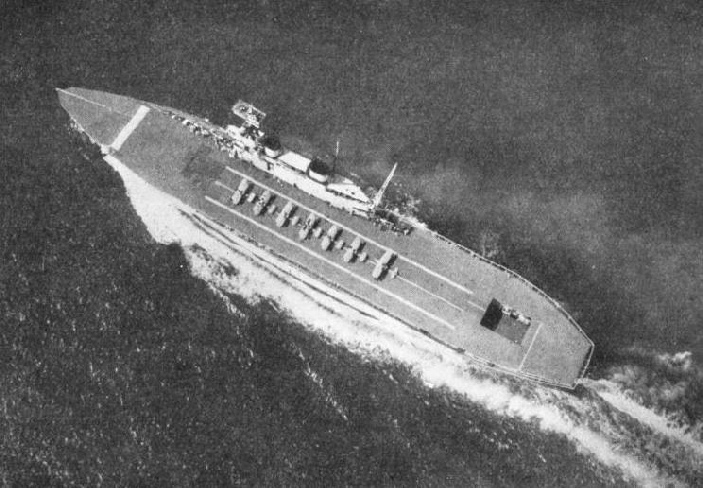
AIRCRAFT CARRIER H.M.S. Eagle was begun in 1913 as a Dreadnought battleship for Chile. After the outbreak of war, work ceased on the ship. Later, her purchase from the Chilean Government was negotiated, and the design modified for an aircraft carrier. The vessel, with a displacement of 22,600 tons, was finally completed in 1923. Her length is 625 feet, beam 92¾ feet, maximum beam 105 feet. Designed shaft horse-power is 50,000, equal to 24 knots. Armament comprises nine 6-in guns, five 4-in and thirty-six smaller. H.M.S. Eagle was refitted in 1932.
The British Admiralty’s undiminished faith in the utility of the battleship is shared by the naval staffs of the United States, Japan, France and Italy, a consensus of professional opinion which cannot lightly be ignored. Because the battleship carries heavier guns and stouter armour than any other type of man-of-war its supremacy among surface ships is self-evident. Provided it can be given adequate protection against mines, torpedoes, and aerial bombing the battleship will remain the dominant factor in naval warfare. Naval architects claim that such protection is perfectly feasible. The war-time function of the battleship is to defeat or neutralize the corresponding forces of the enemy. Cruisers alone are not sufficient to guard the trade routes, for at any time they are liable to be overwhelmed by hostile battleships.
There could be no better illustration of the indispensable part which the battleship plays in British strategy than the operations of the Tenth Cruiser Squadron during the war of 1914-18. This was the force which maintained the blockade of the North Sea. Its “beat” extended from the Norwegian coast far out into the Atlantic, covering every possible northern approach to the European Continent. The squadron consisted of merchant liners armed with guns up to 6-in calibre. Not one of them could have stood up even to the smallest regular cruiser, yet year after year they cruised and patrolled within easy reach of the German naval bases and were never molested save by submarines.
The Germans, of course, knew all about these ships, where they were to be found, and the easy prey they would fall to regular warships. But from beginning to end the powerful German battleships and cruisers made no move against them. Why? Because in distant Scapa, shrouded in the northern mists, lay our mighty fleet of Dreadnoughts, ready at a moment’s notice to put to sea, and cut off any raiding force that attempted to roll up the blockading cruisers.
Power of Grand Fleet
Thus, although these armed merchant liners might be hundreds of miles distant from the Grand Fleet, it shielded them as surely as if it had been within gunshot. In fact, the power of the Grand Fleet, embodied in its great battleships with their ponderous guns, was projected thousands of miles beyond the North Sea. It covered the cruisers that were hunting down enemy raiders in the Pacific, the South Atlantic, and the Indian Ocean, just as it was the invisible but impregnable rampart behind which our antisubmarine patrols - numbering 3,000 vessels of various types - performed their work in almost complete security.
Well might the naval staffs of this and every other country acclaim the battleship “the backbone of sea power”, in view of the decisive part it played in the campaign of 1914-18.
Next in importance is the cruiser, the type of ship which, under the aegis of the battle fleet, is directly responsible for keeping the arterial seaways open to trade. In this class of vessel, speed, seaworthiness and great steaming endurance are more important than gun-power and protection. As, however, cruisers are needed for co-operation with the battle fleet as well as for trade protection and the escort of ocean convoys, they must be capable of holding their own against the cruising ships of possible enemies.
The cruiser is the most widely known symbol of British naval power. It is to be found, either singly or in squadrons, in most parts of the globe. At the time of writing we have forty cruisers in full commission, and no fewer than thirty-two of these are serving abroad. Our foreign squadrons are eked out by the cruiser’s “little sister”, the sloop, a small and lightly armed vessel of negligible fighting value, but useful for police work in peace and for mine-sweeping in war. More than twenty of these little ships are now serving on foreign stations.
A comparative newcomer to the Navy list is the aircraft-carrier. In its latest form the carrier is essentially a sea-going aerodrome, complete with “flying field”, hangars, workshops, petrol and oil depots, and magazines.
The destroyer has been aptly termed the Fleet’s “maid-of-all-work”. Certainly it was used for every conceivable purpose in the war of 1914-18. It launched torpedo attacks against hostile battleships, screened the Grand Fleet from U-boats, escorted convoys, chivvied submarine raiders, laid mines and swept mines, and at odd moments served as a “taxi” for Cabinet Ministers who wished to cross the Channel in a hurry. For as long as navies sail the seas the destroyer is bound to remain an indispensable unit. And so it would seem will the submarine, although a subsequent chapter will show that its sinister reputation is not wholly deserved.
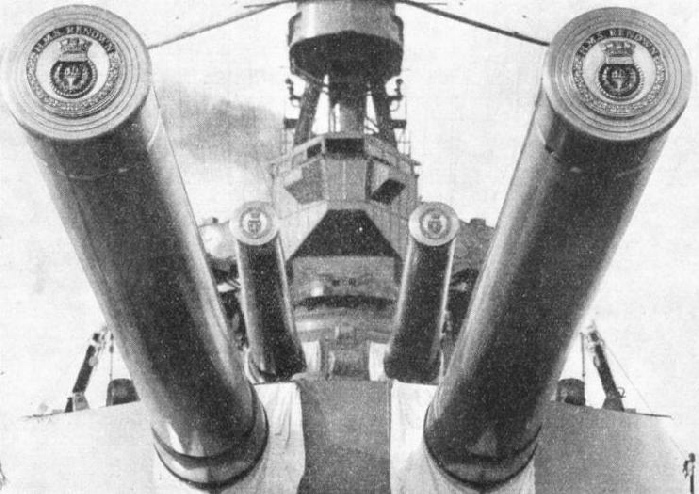
HUGE GUNS OF H.M.S. RENOWN. This famous battle-cruiser has a displacement of 32,000 tons and a normal speed of about 28 knots. She was completed in 1916, and is equipped with six 15-in guns and several smaller guns. She is the sister ship of H.M.S. Repulse.
You can read more on “In the Royal Navy”, “The Navy Goes to Work” and “Navy Week” on this website.













